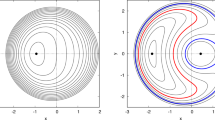Abstract
Relative motion improvements have traditionally focused on inserting additional force models into existing formulations to achieve greater fidelity, or complex expansions to admit eccentric orbits for propagation. A simpler approach may be numerically integrating the two satellite positions and then converting to a modified equidistant cylindrical frame for comparison in a Hill’s-like frame. Recent works have introduced some approaches for this transformation within the Hill’s construct, and examined the accuracy of the transformation. Still others have introduced transformations as they apply to covariance operations. Each of these has some orbital or force model limitations and defines an approximate circular reference dimension. We develop a precise transformation between the Cartesian and curvilinear frame along the actual satellite orbit and test the results for various orbital classes. The transformation has wide applicability.










Similar content being viewed by others
Notes
We use the term “sigma points” to indicate the depiction of an ellipsoid by its 6 principal points. These points fully describe the ellipsoid and they lie along the eigen-axes of the ellipsoid. There are two methods we use. One finds the 6 points to describe the ellipsoid (eigenvalue decomposition), and one to find the ellipsoid given just the 6 points (minimum volume enclosing ellipsoid algorithm).
Surface points are used in the inverse transformation because using the sigma points would yield the same ellipsoid as in Fig. 8. The number of surface points taken depends on the desired grid and fineness of the resulting ellipsoid.
References
Alfriend, K.T., Yan, H.: An evaluation and comparison of relative motion theories. AIAA J. Guid. Control Dyn. 26(2), 254–263 (2005)
Clohessy, W.H., Wiltshire, R.S.: Terminal guidance system for satellite rendezvous. J. Aerosp. Sci. 27(9), 653–674 (1960)
Fasano, G., D’Errico, M.: Modeling orbital relative motion to enable formation design from application requirements. Celest. Mech. Dyn. Astron. 105, 113–139 (2009)
Gim, D.-W., Alfriend, K.T.: State transition matrix of relative motion for the perturbed noncircular reference orbit. J. Guid. Control Dyn. 26(6), 956–971 (2003)
Gomez, G., Marcote, M.: High-order analytical solutions of Hill’s equations. Celest. Mech. Dyn. Astron. 94, 197–211 (2006)
Hill, K., Alfriend, K.T., Sabol, C.: Covariance-based uncorrelated track association. In: Paper AIAA 2008–7211 Presented at the AIAA/AAS Astrodynamics Specialist Conference. Honolulu, HI. August 18–21 (2008)
Hill, K. et al.: Covariance-based network tasking of optical sensors. In: Paper AAS 10–150 Presented at the AAS/AIAA Space Flight Mechanics Conference, February 14–17. San Diego, CA. (Also 8th USR Workshop, Maui, April 8–13, 2010, Paper S5.2) (2010)
Hill. K., Sabol, C., Alfriend, K.T.: Comparison of covariance-based track association approaches with simulated radar data. In: Paper AAS 10–318 Presented at the Kyle T. Alfriend Astrodynamics Symposium. Monterey, CA. May 17–19 (2010)
Hill, G.W.: Researches in lunar theory. Am. J. Math. 1, 5–26 (1878)
Junkins, J.L., Akella, M.R., Alfriend, K.T.: Non-Gaussian error propagation in orbital mechanics. J. Astronaut. Sci. 44(4), 541–563 (1996)
Martinusi, V., Gurfil, P.: Solutions and periodicity of satellite relative motion under even zonal harmonics perturbations. Celest. Mech. Dyn. Astron. 111, 387–414 (2011)
Melton, R.G.: Time-explicit representation of relative motion between elliptical orbits. J. Guid. Control Dyn. 23(4), 604–610 (2000)
Moiseev, I.: Personal Discussions. Code at http://elliptic.googlecode.com, Accessed June 2013 (2013)
Park, R.S., Scheeres, D.J.: Nonlinear mapping of Gaussian statistics: theory and applications to spacecraft trajectory design. J. Guid. Control Dyn. 29(6), 1367–1375 (2006)
Sabol, C. et al.: Linearized orbit covariance generation and propagation analysis via simple Monte Carlo simulations. In: Paper AAS 10–134 Presented at the AAS/AIAA Space Flight Mechanics Conference, February 14–17. San Diego, CA. (Also 8th USR Workshop, Maui, April 8–13, 2010, Paper S4.1) (2010)
Schweighart, S.A., Sedwick, R.J.: High fidelity linearized J2 model for satellite formation flight. J. Guid. Control Dyn. 25(6), 1073–1080 (2002)
Tschauner, J., Hempel, P.: Rendezvous with a target in an elliptical orbit. Astronaut. Acta 11(2), 104–109 (1965)
Vallado, D.A.: Fundamentals of Astrodynamics and Applications, 1st edn. McGraw Hill, New York (1997)
Vallado, D.A.: Fundamentals of Astrodynamics and Applications, 4th edn. Microcosm, Hawthorne, CA (2013)
Weisstein, E.W. (2011). Cylindrical equidistant projection. From MathWorld-A Wolfram Web Resource. http://mathworld.wolfram.com/CylindricalEquidistantProjection.html
Author information
Authors and Affiliations
Corresponding author
Rights and permissions
About this article
Cite this article
Vallado, D.A., Alfano, S. Curvilinear coordinate transformations for relative motion. Celest Mech Dyn Astr 118, 253–271 (2014). https://doi.org/10.1007/s10569-014-9531-1
Received:
Revised:
Accepted:
Published:
Issue Date:
DOI: https://doi.org/10.1007/s10569-014-9531-1




